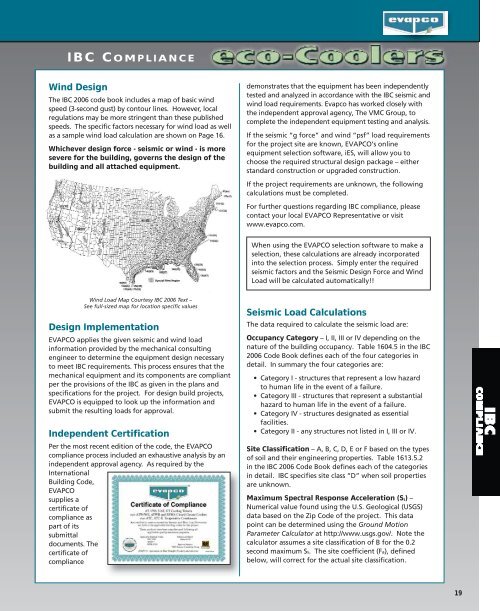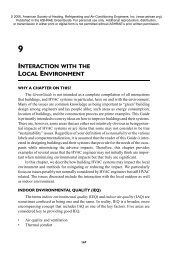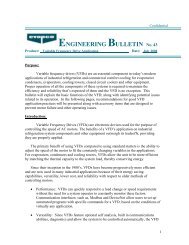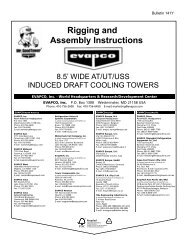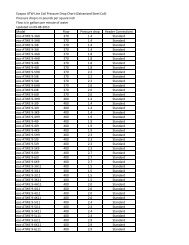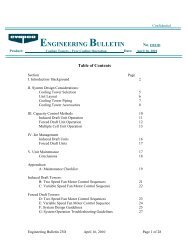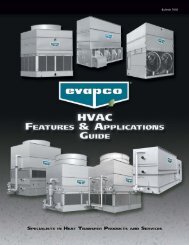eco-ATWB Marketing - Evapco
eco-ATWB Marketing - Evapco
eco-ATWB Marketing - Evapco
You also want an ePaper? Increase the reach of your titles
YUMPU automatically turns print PDFs into web optimized ePapers that Google loves.
IBC COMPLIANCE<br />
Wind Design<br />
The IBC 2006 code book includes a map of basic wind<br />
speed (3-s<strong>eco</strong>nd gust) by contour lines. However, local<br />
regulations may be more stringent than these published<br />
speeds. The specific factors necessary for wind load as well<br />
as a sample wind load calculation are shown on Page 16.<br />
Whichever design force - seismic or wind - is more<br />
severe for the building, governs the design of the<br />
building and all attached equipment.<br />
demonstrates that the equipment has been independently<br />
tested and analyzed in accordance with the IBC seismic and<br />
wind load requirements. <strong>Evapco</strong> has worked closely with<br />
the independent approval agency, The VMC Group, to<br />
complete the independent equipment testing and analysis.<br />
If the seismic “g force” and wind “psf” load requirements<br />
for the project site are known, EVAPCO’s online<br />
equipment selection software, iES, will allow you to<br />
choose the required structural design package – either<br />
standard construction or upgraded construction.<br />
If the project requirements are unknown, the following<br />
calculations must be completed.<br />
For further questions regarding IBC compliance, please<br />
contact your local EVAPCO Representative or visit<br />
www.evapco.com.<br />
When using the EVAPCO selection software to make a<br />
selection, these calculations are already incorporated<br />
into the selection process. Simply enter the required<br />
seismic factors and the Seismic Design Force and Wind<br />
Load will be calculated automatically!!<br />
Wind Load Map Courtesy IBC 2006 Text –<br />
See full-sized map for location specific values<br />
Design Implementation<br />
EVAPCO applies the given seismic and wind load<br />
information provided by the mechanical consulting<br />
engineer to determine the equipment design necessary<br />
to meet IBC requirements. This process ensures that the<br />
mechanical equipment and its components are compliant<br />
per the provisions of the IBC as given in the plans and<br />
specifications for the project. For design build projects,<br />
EVAPCO is equipped to look up the information and<br />
submit the resulting loads for approval.<br />
Independent Certification<br />
Per the most recent edition of the code, the EVAPCO<br />
compliance process included an exhaustive analysis by an<br />
independent approval agency. As required by the<br />
International<br />
Building Code,<br />
EVAPCO<br />
supplies a<br />
certificate of<br />
compliance as<br />
part of its<br />
submittal<br />
documents. The<br />
certificate of<br />
compliance<br />
Seismic Load Calculations<br />
The data required to calculate the seismic load are:<br />
Occupancy Category – I, II, III or IV depending on the<br />
nature of the building occupancy. Table 1604.5 in the IBC<br />
2006 Code Book defines each of the four categories in<br />
detail. In summary the four categories are:<br />
• Category I - structures that represent a low hazard<br />
to human life in the event of a failure.<br />
• Category III - structures that represent a substantial<br />
hazard to human life in the event of a failure.<br />
• Category IV - structures designated as essential<br />
facilities.<br />
• Category II - any structures not listed in I, III or IV.<br />
Site Classification – A, B, C, D, E or F based on the types<br />
of soil and their engineering properties. Table 1613.5.2<br />
in the IBC 2006 Code Book defines each of the categories<br />
in detail. IBC specifies site class “D” when soil properties<br />
are unknown.<br />
Maximum Spectral Response Acceleration (Ss) –<br />
Numerical value found using the U.S. Geological (USGS)<br />
data based on the Zip Code of the project. This data<br />
point can be determined using the Ground Motion<br />
Parameter Calculator at http://www.usgs.gov/. Note the<br />
calculator assumes a site classification of B for the 0.2<br />
s<strong>eco</strong>nd maximum Ss. The site coefficient (Fa), defined<br />
below, will correct for the actual site classification.<br />
19


